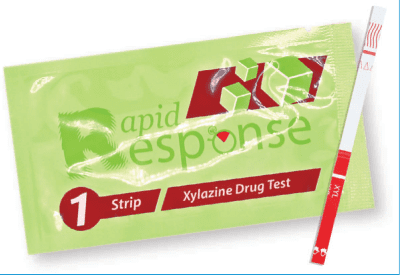Be alert for the signs of this drug, a growing contributor to the opioid epidemic.
- In addition to the influx of fentanyl in the illicit drug supply, xylazine, another adulterant, is being detected and involved in drug overdose deaths.
- Xylazine, an animal tranquilizer, isn’t approved for human use and causes dramatic physiologic effects and places individuals who use illicit drugs at high risk for morbidity and mortality.
- Xylazine should be suspected in drug overdoses when patients don’t respond to naloxone.
- Broad education to healthcare professionals and the community at large can aid recognition.
Fentanyl, a synthetic, short-acting opioid 50 times stronger than heroin, was originally approved in 1972 by the Food and Drug Administration (FDA) as a pain medication and I.V. anesthetic. In 1982, reports identified misuse of the drug, and within two decades it had infiltrated the illicit U.S. heroin supply as an adulterant (a pharmacologically active substance added to an illicit drug). In a recent report by the DC Office of the Chief Medical Examiner, by 2017, fentanyl was the prevalent opioid found in overdose deaths with an increase in fentanyl-related deaths from 62% in 2016 to 94% in 2020.
Addressing substance use disorder and diversion in the healthcare environment
Opioid overdose in the community
NP role in medication-assisted treatment for opioid use disorder
When fentanyl was first introduced into the illicit heroin market, those using opioids fell victim to highly potent, addictive, often life-threatening fentanyl-laced heroin and other drugs, including counterfeit pills. Based on reports by Hochstatter and colleagues and the U.S. Drug Enforcement Administration, although many individuals who use opioids unknowingly ingest fentanyl, many others purposefully seek it for its greater potency, which has resulted in increasing mortality nationwide. (See Drug overdose stats.)
Fentanyl test strips, an effective harm reduction strategy, can determine whether illicit drugs contain fentanyl or fentanyl analogs. However, these strips have several limitations; for instance, they measure only the presence or absence of the drug (albeit at limits as low as 0.100 mcg/mL), not its concentration. Also, as reported by Appel and colleagues, law enforcement in many states consider the strips drug paraphernalia, and not all individuals who use drugs can access them.
Fortunately, the opioid overdose antidote naloxone (Narcan) is now available without a prescription in pharmacies, harm reduction centers, drug recovery centers, and in some school districts (depending on the state). To reduce the escalating mortality from opioid overdoses, many community agencies now distribute naloxone to at-risk populations, recommend never using drugs alone, suggest using test strips to check for the presence of fentanyl, and encourage the use of available harm reduction centers when engaging in drug use.
Despite these advancements in detecting fentanyl and reversing overdoses, a new adulterant poses an even greater threat.
Drug overdose stats
According to the United Nations Office on Drugs and Crime, North America has the highest drug-related mortality in the world, and it continues to worsen.
- The Centers for Disease Control and Prevention reported that, from 2019 to 2020, more than 564,000 people died from overdoses involving illicit and prescribed opioids.
- In 2018, the National Center for Health Statistics reported 67,367 drug overdose deaths.
- According to the National Institute on Drug Abuse, from 2019 to 2021, more than 106,000 deaths related to drug overdoses occurred, most as a result of synthetic opioids (fentanyl).
- The Drug Enforcement Administration reports illicit fentanyl as the primary factor in the dramatic increase in opioid-related mortality.
A new adulterant: Xylazine
Bowles and associates reported an increasing involvement of xylazine, a highly dangerous, novel emergent adulterant, in drug overdose mortality and morbidity across North America. According to Reed and associates, xylazine has most severely affected populations in the eastern United States, Puerto Rico, and Canada. In a mixed-method study, Friedman and colleagues identified xylazine as a factor in national overdose deaths five times higher in 2020 than in 2015.
Xylazine, developed in 1962 by the Bayer Corporation, is a clonidine analog used for large animal sedation and anesthesia; it’s not approved for human use and requires a veterinary license for purchase. Its misuse was first detected in the early 2000s in Puerto Rico where it was called anestesia de caballo (horse anesthesia), according to findings reported by Reed and colleagues. In 2007, it was detected in Philadelphia under the street name tranq (or trank). Other street names include sleep-cut, zombie drug, and Philly dope. Data collected by Knopf reveal that an alarming 38 states have reported the presence of xylazine in overdoses. The DEA Joint Intelligence Report documents the identification of xylazine in all U.S. regions, which indicates increased use.
As an illicit drug for humans, xylazine is easily available for purchase on internet sites that aren’t associated with veterinarian use. Regulation efforts by government agencies aim to classify the drug as a controlled substance.
Xylazine effects
Xylazine prolongs the effects of fentanyl, costs less than fentanyl, and serves as a bulking additive to increase the supply of illicit drugs. It depresses the central nervous system, increasing the likelihood of unintentional overdose. Xylazine causes hypotension, bradycardia, hyperglycemia, hypothermia, profound sedation, coma, dysrhythmia, and respiratory depression. These dramatic physiologic effects ultimately place the individual at high risk for morbidity due to cardio-respiratory events and injuries sustained during periods of stupor or unresponsiveness. In addition, prolonged and profound unresponsiveness increases the risk for violence-related harm.
Xylazine can be taken orally, but I.V. use is most common, which has resulted in the increasing incidence of severe wound infections. These necrotizing wounds present as much worse than the cellulitis or abscesses frequently seen with other illicit I.V. drug use, and they occur not only at injection sites. Reports indicate higher amputation rates among those injecting drugs adulterated with xylazine than those without. Similar to burns, these severe infections form eschar, which when observed in combination with prolonged unresponsiveness (even after administration of naloxone), indicate possible xylazine toxicity.
Nursing implications
When encountering an individual with a suspected overdose of fentanyl or heroin that contains xylazine, remember that naloxone has no effect. The patient may remain unresponsive and in a state of stupor with continued respiratory depression, even after receiving naloxone. Kariisa and colleagues recommend immediate respiratory and cardiovascular supportive care.
Until recently, routine toxicology tests couldn’t detect xylazine, and test strips weren’t available. However, xylazine test strips have been developed and may soon be widely distributed. Distinguishing opioid overdose from xylazine overdose remains challenging in clinical settings as well as on the streets. And unlike medication-assisted treatment (buprenorphine, naltrexone, and methadone) for individuals with opioid use disorders, no standard treatment exists for xylazine toxicity and withdrawal; abrupt cessation of xylazine can result in severe withdrawal. Symptomatic and supportive management remains the current approach. (See Xylazine toxicity and future considerations.)
Xylazine toxicity and future considerations
Nurses play an important role in the effort to reduce morbidity and mortality related to xylazine use and overdose. Keep in mind the following signs of xylazine overdose and recommended actions. Also, advocate for and participate in steps for future consideration.
- Bradycardia
- Hypotension
- Hypothermia
- Respiratory distress
- Staggering
- Stupor
- Unresponsiveness
Recommended actions
- Administer naloxone.
- Place in recovery position.
- Provide cardiac and respiratory support.
- Administer I.V. fluids.
- Provide wound management and antibiotics as prescribed.
- Supply information for outpatient rehabilitation programs for opioid and xylazine withdrawal/treatment/recovery.
Future considerations
- Distribute xylazine test strips.
- Promote harm reduction strategies such as the following:
- Don’t use drugs alone.
- Use drugs in harm reduction centers with available support and assessment.
- Assess skin for altered integrity.
- Seek early treatment to avoid severe wound infections and injuries sustained during periods of stupor or unresponsiveness.
- Closely monitor and report xylazine exposure.
Be alert and report
Federal tracking of xylazine use and its effects remains ongoing. The FDA’s MedWatch Adverse Event Reporting Program includes an online mechanism for use by clinicians and individuals to report illicit xylazine exposure (fda.gov/medwatch/report.htm). Suspected xylazine exposures also should be reported to local health departments and poison control centers. Alerting as many healthcare professionals and community support networks as possible to this dangerous adulterant may help reduce fatalities and improve outcomes.
Kathleen Neville is associate dean for graduate studies and research at Seton Hall University College of Nursing in Nutley, New Jersey, and principal investigator of the Substance Abuse and Mental Health Services Administration grant, the Seton Hall University and Hackensack School of Medicine Expanded Interprofessional Medication-Assistant Treatment Training Program. Julia Bonfim is the project coordinator overseeing the grant to train nurse practitioners and physician assistant students at Seton Hall University and Monmouth University in West Long Branch, New Jersey, and medical students at the Hackensack School of Medicine in Nutley, New Jersey, to treat individuals with opioid use disorders.
References
Appel G, Farmer B, Avery J. Fentanyl test strips empower people and save lives—So why aren’t they more widespread? Health Affairs. June 2, 2021. healthaffairs.org/do/10.1377/forefront.20210601.974263
Bowles JM, McDonald K, Maghsoudi N, et al. Xylazine detected in unregulated opioids and drug Administration equipment in Toronto, Canada: Clinical and social implications. Harm Reduct J. 2021;18(104). doi:10.1186/s12954-021-00546-9
Centers for Disease Control and Prevention. Drug overdose deaths in the United States, 1999-2018. January 2020. cdc.gov/nchs/products/databriefs/db356.htm
Centers for Disease Control and Prevention. Overdose deaths accelerating during COVID-19. December 17, 2020. cdc.gov/media/releases/2020/p1218-overdose-deaths-covid-19.html
Centers for Disease Control and Prevention. U.S. drug overdose deaths continue to rise; increase fueled by synthetic opioids. March 29, 2018. www.cdc.gov/media/releases/2018/p0329-drug-overdose-deaths.html
District of Columbia Office of the Chief Medical Examiner. Opioid-related fatal overdoses: January 1, 2017 to October 31, 2022. January 23, 2023. ocme.dc.gov/sites/default/
files/dc/sites/ocme/Opioid%20related%20Overdoses%20Deaths_Jan2023_FINAL.pdf
Drug Enforcement Administration. DEA warns of increase in mass-overdose events involving deadly fentanyl. April 6, 2022. dea.gov/press-releases/2022/04/06/dea-warns-increase-mass-overdose-events-involving-deadly-fentanyl
Friedman J, Montero F, Bourgois P, et al. Xylazine spreads across the US: A growing component of the increasingly synthetic and polysubstance overdose crisis. Drug Alcohol Depend. 2022;233:109380. doi:10.1016/j.drugalcdep.2022.109380
Green TC, Park JN, Gilbert M. An assessment of the limits of detection, sensitivity and specificity of three devices for public health-based drug checking of fentanyl in street-acquired samples. Int J Drug Policy. 2020;77:102661. doi:10.1016/j.drugpo.2020.102661
Hochstatter KR, Terplan M, Mitchel SG, et al. Characteristics and correlates of fentanyl preferences among people with opioid use disorder. Drug Alcohol Depend. 2022;240: 109630. doi:10.1016/j.drugalcdep.2022.109630
Kariisa M, Patel P, Smith H, Bitting J. Notes from the field: Xylazine detection and involvement in drug overdose deaths — United States, 2019. MMWR Morb Mortal Wkly Rep. 2021;70(37):1300-2. doi:10.15585/mmwr.mm7037a4
Knopf A. Non-opioid veterinary sedative xylazine implicated in OD deaths. Alcoholism & Drug Abuse Week. 2021;33(37):5. doi:10.1002/adaw.33205
National Institute on Drug Abuse. Drug overdose death rates. February 9, 2023. https://nida.nih.gov/research-topics/trends-statistics/overdose-death-rates
National Institute on Drug Abuse. Nearly half of opioid-related overdose deaths involve fentanyl. May 1, 2018. https://archives.nida.nih.gov/news-events/news-releases/2018/05/nearly-half-of-opioid-related-overdose-deaths-involve-fentanyl
Reed MK, Imperato NS, Bowles JM, Salcedo VJ, Guth A, Rising KL. Perspectives of people in Philadelphia who use fentanyl/heroin adulterated with animal tranquilizer xylazine; Making a case for xylazine test strips. Drug Alcohol Depend Rep. 2022;4:100074. doi:10.1016/j.dadr.2022.100074
United Nations. World Drug Report 2019. wdr.unodc.org/wdr2019/
U.S. Department of Justice, Drug Enforcement Administration. The Growing Threat of Xylazine and Its Mixture with Illicit Drugs. October 2022. dea.gov/sites/default/files/2022-12/The%20Growing%20Threat%20of%20Xylazine%20and%20its%20Mixture%20with%20Illicit%20Drugs.pdf
U.S. Food and Drug Administration. FDA warns about the risk of xylazine exposure in humans. November 8, 2022. fda.gov/media/162981/download
Key words: xylazine, xylazine toxicity, fentanyl, opioid use disorders, drug overdose deaths




















1 Comment. Leave new
Very well written and informative article.